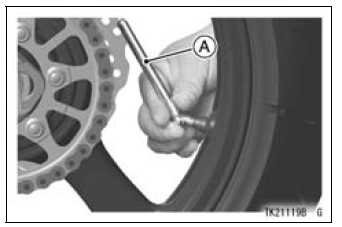

Failure to maintain proper inflation pressures or observe payload limits for your tires may adversely affect handling and performance of yourmotorcycle and can result in loss of control. The maximum recommended load in addition to vehicle weight is 180 kg (397 lb), including rider, passenger, baggage, and accessories.
NOTE

A. Tire Pressure Gauge
Tire Air Pressure (when cold)

 Wheels
Wheels Tire Wear, Damage
Tire Wear, DamageMain Throttle Sensor Input Voltage Inspection
NOTE
Be sure the battery is fully charged.
Turn the ignition switch to OFF.
Remove the throttle body assy (see Throttle Body Assy
Removal in the Fuel System (DFI) chapter).
Do not disconnect the connectors of the throttle body
assy.
Disconnect the main throttle sensor connector ...
Shift Pedal Installation
Install the rubber damper to the shift pedal.
Turn the chamfered side to inside.
Assemble:
Shift Lever [A] and Locknut [B] (Left-hand Thread)
Shift Pedal [C] and Locknut [D]
Tie-Rod [E]
Turn the grooved end [F] of the tie-rod to the shift lever.
Apply grease to the sliding ...
Lighting System
This motorcycle adopt the daylight system and have a
headlight relay in the relay box. The headlight does not
go on when the ignition switch and the engine stop switch
are first turned on. The headlight comes on after the starter
button is released and stays on until the ignition switch is
turn ...